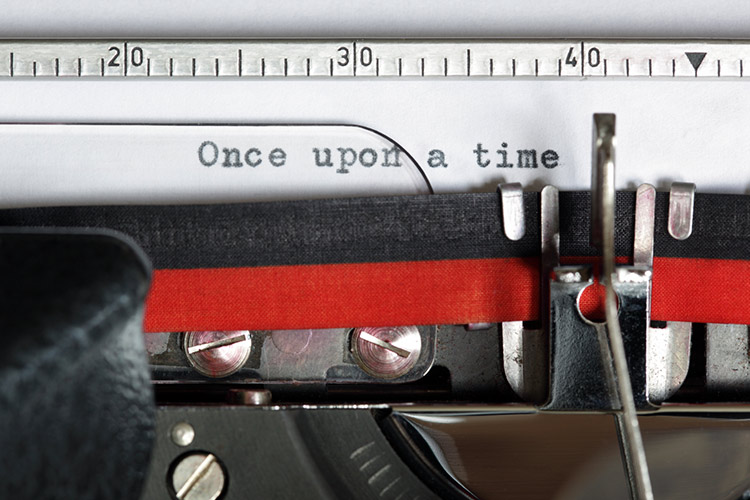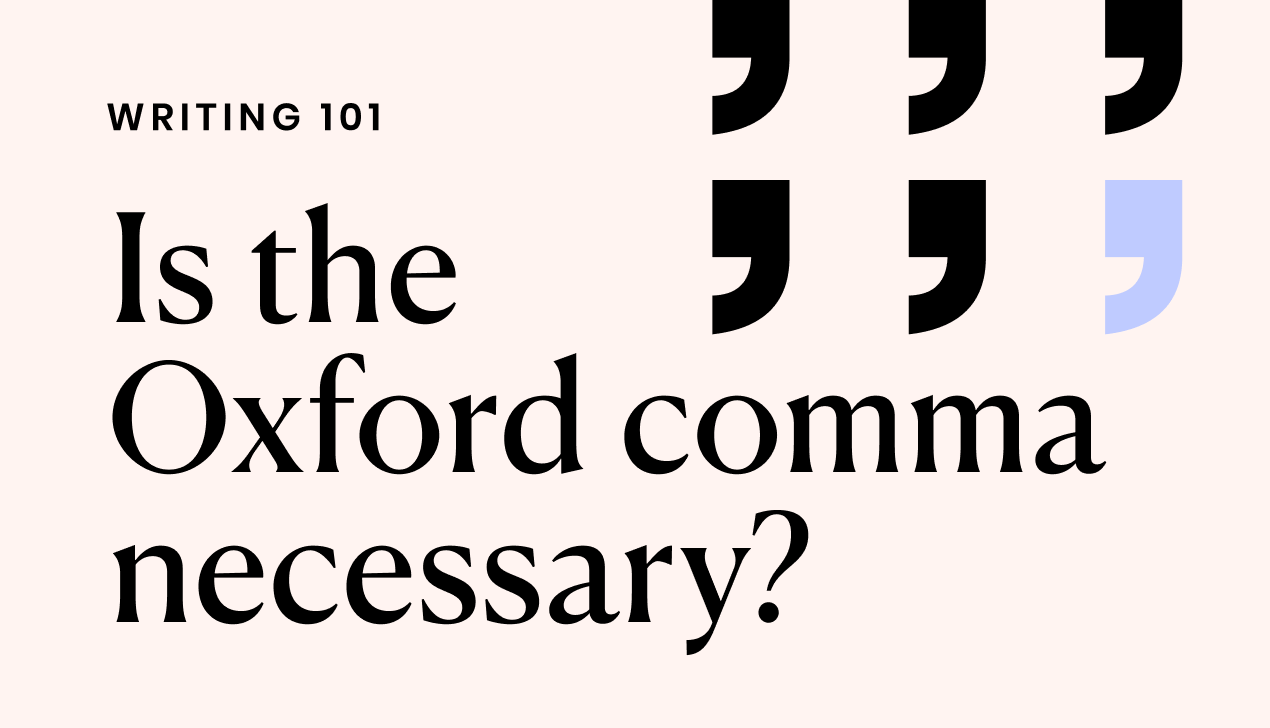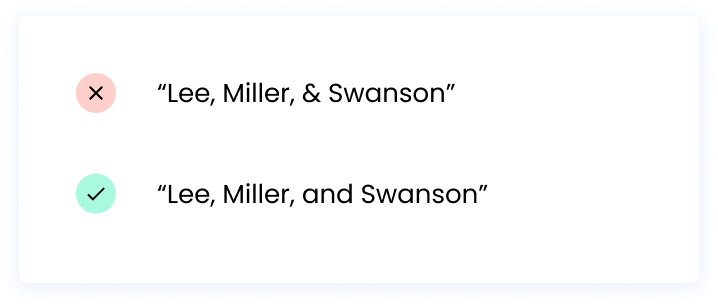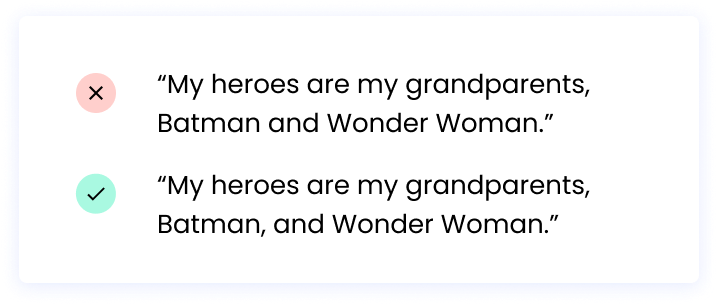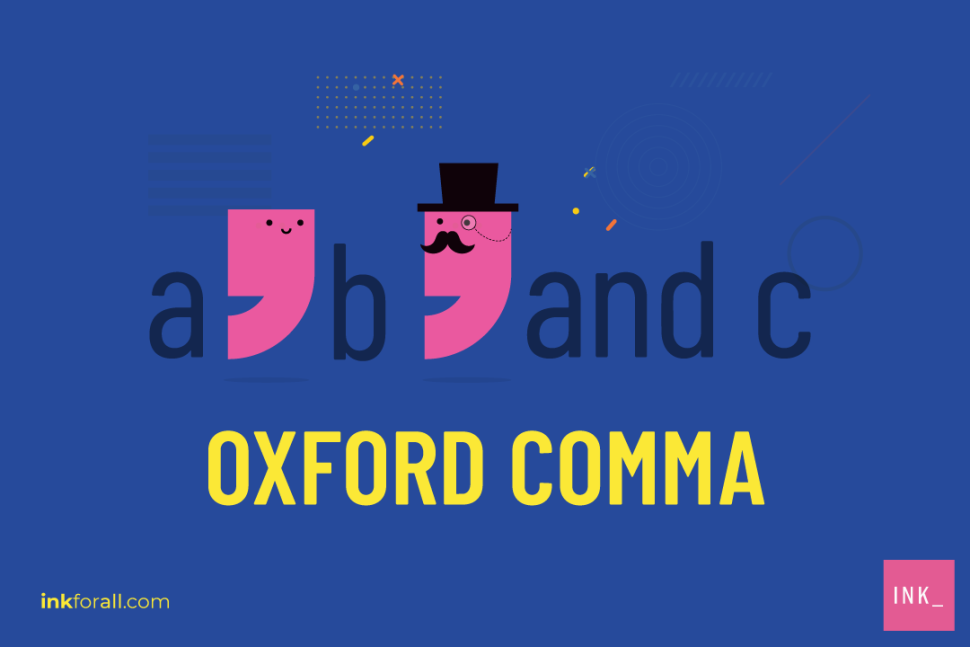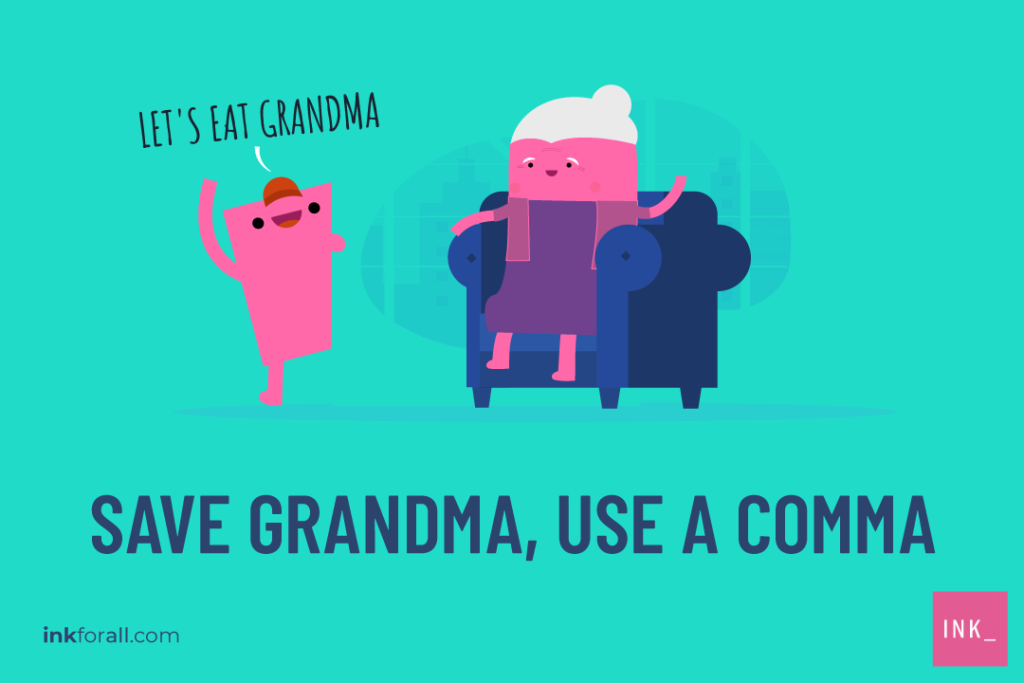What is oxford comma
What is oxford comma
What is the Oxford Comma?
“There are people who embrace the Oxford comma, and people who don’t, and I’ll just say this: never get between these people when drink has been taken.”
So says Lynne Truss, author of the hugely successful punctuation bible “Eats Shoots & Leaves”, in reference to the surprising strength of opinion surrounding the use of the Oxford comma. The alleged importance of the Oxford comma has been humorously depicted in numerous internet memes, while its debatable significance has even been the subject of a popular song by the band Vampire Weekend. But why is it that people have such robust opinions about such a tiny and seemingly harmless bit of punctuation, and has this controversial comma had its day? In this article, we look in detail at the arguments for and against the use of the Oxford comma and try to get to the bottom, once and for all, of whether or not we really need it.
What is an Oxford comma?
To give the Oxford comma its technical definition, it is a comma used before the final conjunction in a list of three or more items. When you’re writing a list, you naturally include commas to separate each item, but an Oxford comma is when you also put a comma before the “and [Final Item]”. For example:
Without Oxford comma: “Her favourite foods were chocolate, marshmallows, cake and chicken.”
With Oxford comma: “Her favourite foods were chocolate, marshmallows, cake, and chicken.”
The Oxford comma is also used in exactly the same way in lists in which the conjunction is the word “or” or “nor”.
Other names for the Oxford comma
The Oxford comma is technically called a “serial comma”, or “series comma”, but it’s become popularly known as the “Oxford comma” thanks to its famous use by Oxford University Press, a publishing
house in Oxford, the style guide of which has required the use of an Oxford comma since as far back as 1905. The Oxford comma is occasionally also known as a Harvard comma on account of its well-known use at Harvard University Press.
Who uses Oxford commas and who opposes them?
Traditionally, the omission of the Oxford comma has been more common in newspaper publishing, where strict character limits are required in the narrow confines of printed columns. There is no consistency in its use or omission when looking at historical texts (it’s been used for centuries, but people have also been omitting it for centuries), but today, its use is generally more common among American style guides than it is among British ones. The Times and The Economist, for instance, are both against its use. Many well-known American guides, such as The Chicago Manual of Style, advocate it, though there are notable exceptions, such as the Associated Press Stylebook. Others, such as The Guardian, are more flexible, arguing that it should be used only in situations when it is required to avoid ambiguity. Interestingly, many languages – including French, German and Italian – do not use the Oxford comma at all.
The arguments in favour of the Oxford comma
Many people who have a passion for good grammar argue strongly in favour of the Oxford comma, lamenting the fact that many style guides have unceremoniously binned it. Let’s look first at the reasons why so many people still advocate the use of the Oxford comma and see if we can understand why supporters almost militantly defend its use.
Clarity and precision
The biggest argument in favour of using the Oxford comma is for clarity. Sometimes, many people argue, the Oxford comma isn’t just a stylistic feature, but an essential one, as the meaning of a sentence can be altered without it. It is therefore important for removing potential ambiguity that can spoil the clarity and elegance of your writing.
In the example we gave above, the version without the Oxford comma could be interpreted as meaning that one of the girl’s favourite foods was “cake and chicken” mixed together. Adding the Oxford comma makes it clear that these are two separate foods. To give you another example, take a look at this sentence:
“They sent gifts to her sons, Kate and Sophie.”
This makes it sound as though the woman’s sons are called Kate and Sophie, but we know that these are female names, which makes the sentence illogical and jarring. Adding the Oxford comma, we get:
“They sent gifts to her sons, Kate, and Sophie.”
With the Oxford comma, it becomes clear that gifts are being sent to her sons in addition to being sent to two other people called Kate and Sophie. It’s a fine difference, but an important one, and it’s a good illustration of why grammar purists argue that the Oxford comma makes one’s writing more precise and deliberate.
Another situation in which an Oxford comma is helpful in adding clarity is when a list consists of more complex terms or clauses. For example:
“Please can you fetch me some bread and cheese, orange juice and lemonade, and my throat sweets.”
Without the Oxford comma, the sentence becomes harder to read because there are already other conjunctions grouping pairs of things that belong together as single items on a list. Similarly, in a list of terms that may be unfamiliar to the reader:
“The subjects in the Quantum Mechanics lecture will include the black-body radiation problem, mathematical formulations, and the Copenhagen interpretation.”
The reader can thus see that these are individual topics to be discussed, regardless of whether they have any pre-existing knowledge of Quantum Mechanics or what these subjects are about. Without the Oxford comma, one might surmise that the Copenhagen interpretation relates specifically to the mathematical formulations, while what is actually being communicated is that these are discrete subjects.
It more closely replicates the spoken rhythm of the sentence
Others add to this persuasive argument in favour of the Oxford comma by pointing out that its use more closely matches the spoken rhythm of a list. To see what we mean, try reading out a list of items and see how your rhythm alters when you reach the end of it. Did you add an extra pause to indicate that the last two items on the list were two separate things rather than combined? The purpose of commas is to separate and indicate short pauses between clauses, to make your writing easy to read and understand; we do exactly the same thing when we are speaking out loud. When you’re reciting a list of things out loud, the chances are that you probably would put a short pause before the final item, and the Oxford comma reflects that.
The arguments against the Oxford comma
So far, the arguments in favour of using the Oxford comma seem pretty compelling. Why on earth would anyone contest using punctuation that makes your meaning more clear, or more accurately replicates the way you would speak a sentence out loud? We now turn to the equally passionate arguments against the use of the Oxford comma. See which you find more persuasive…
Hypercorrect?
The use of the Oxford comma, many people argue, is overly pedantic, and in some situations, its use can sound pompous and hypercorrect. It is usually perfectly possible to discern the meaning of a sentence without it. It’s pretty obvious, for example, that the girl in the example above would enjoy cake and chicken as two separate foods, not together. To suggest that readers need an extra comma just to be able to understand this is surely underestimating the intelligence of one’s readers. What’s more, adding the extra comma when it isn’t necessary arguably disrupts the flow of the sentence, and those opposed to the Oxford comma might argue that it sounds more natural to read it without the short pause before the final item.
Creating ambiguity
Pomposity and excessive pedantry aren’t the only arguments against the Oxford comma, however. We have seen that its use can prevent ambiguity, but in certain situations it can actually create ambiguity. This can arise as a result of a construction called an apposition, which is used to add identifying information about the previous clause. For example:
“We are working with John, a farmer, and Tom.”
It’s easy to read this sentence as meaning “We are working with two people – a farmer called John and another person called Tom”. In this case, the Oxford comma before the final conjunction has added confusion, because it means that “the farmer” can now be read as an apposition. If the meaning of the sentence was actually that we are working with three people – John, Tom and a farmer – then either removing the Oxford comma or rephrasing altogether would be more clear.
Isn’t the conjunction enough?
What’s more, it can be argued that the conjunction in itself provides enough of a separation between the final two items. It is, after all, what the conjunction is there for, and one could argue that the comma is therefore superfluous – even tautological (a tautology, for those not in the know, being a stylistic error occurring when there is an unnecessary repetition of meaning – but that’s a whole other linguistic minefield).
Why not just rephrase?
If there really is ambiguity when an Oxford comma isn’t used, rephrasing a sentence can often be a better option than using an Oxford comma. For instance, in the last example, we might say “They sent gifts to her sons and to Kate and Sophie”. Some might counter this argument by suggesting that adding a simple comma takes less time than rephrasing a sentence, but if the end result is a more elegantly worded sentence, then one could equally well argue that it is time well spent.
Is use of the Oxford comma ultimately just a matter of personal preference?
It’s easy to end up sitting on the fence when it comes to the Oxford comma; its use often is a matter of preference, and this is reflected in the fact that some style guides insist on its use while others insist on it not being used. But perhaps sitting on the fence is the right position to take when it comes to the Oxford comma, because deciding on a case-by-case basis whether or not to use it is arguably a more intelligent approach than advocating its blanket use or banning it completely.
To throw yet another spanner into the works, and in favour of using the Oxford comma on a case-by-case basis, still others argue that the Oxford comma isn’t necessary when listing items that are related to each other, but it is when introducing items that are not related to each other. To follow this argument, you might talk about “sheep, pigs and cows” without an Oxford comma, because they are all farm animals, but you would use one when referring to unrelated items such as “tables, clothes, and food.” However, this idea is not an accepted rule, and seems more of a personal reimagining of Oxford comma usage.
Irrespective of this particular line of argument, flexibility seems an appropriate response to this surprisingly complex punctuation issue. That’s because although some might argue that rephrasing removes the need to quibble over its usage, there are still some situations in which the use of the Oxford comma is warranted and others in which it is unnecessary. One might also argue, though, that consistency is important, and that it is better to choose whether to use it or not and then apply that rule consistently, at least across the same document if not across all wider publications as part of a house style.
In the absence of any hard and fast rules in favour of the Oxford comma or against it, it seems that it will continue to be one of those grammatical nuances that’s subjective enough to provoke heated debate. Where do you stand on the troublesome Oxford comma?
Oxford comma: is it necessary?
Jessica Malnik
Want to know the quickest way to start a heated debate among writers, editors, and English teachers? Ask this question.
Is the Oxford comma necessary?
It seems like writers are willing to go to war over the Oxford comma. Some are diehard fans, and others insist it should be banished from the English language.
So, should you be using the Oxford comma? And when do you need to use it?
In this post, we’ll cover the basics that you need to know about the use of the Oxford comma, including the rules that apply to it, whether or not it’s grammatically correct, and examples of the correct and incorrect way to use it.
What’s the Oxford comma rule?
The Oxford comma, a.k.a. the serial comma, is the last comma in a list. The Oxford comma should be placed before the word “and” at the end of a list.
Here’s a quick example of what a sentence with the Oxford comma would look like:
I have three dogs named Blaze, Buster, and Dash.
The same sentence without the Oxford comma would read:
I have three dogs named Blaze, Buster and Dash.
Whether or not you choose to add a comma will depend on the style guide you follow. For instance, AP Style doesn’t require the Oxford comma, while the Chicago Manual of Style requires it in almost all cases. Be sure to check with the style guide you use to see if the Oxford comma is a requirement or not.
Writer for Chrome
Clear, concise and error-free
Start your free 30-day trial
Are Oxford commas grammatically correct?
As mentioned in the section above, whether or not you use the Oxford comma will depend on the style guide you follow. Some style guides require you to use it, while others, like the Associated Press Stylebook, consider it unnecessary.
The type of writing you’re doing, the meaning of a sentence, and your personal preference will also come into play.
Rest assured that regardless of what grammarians, English teachers, and your friends may think, you won’t be breaking any grammar rules if you include or omit the Oxford comma in your writing.
Even if it isn’t a grammatical faux pas, the Oxford comma does have its place. For instance, lawyers or legal writers are encouraged to include the Oxford comma for clarity. While the serial comma does help clarify lists, it can interfere with good sentence composition and flow. Many journalists are against it for this reason. Some even argue that it makes for lazy writing or clutters the piece with unnecessary punctuation.
Here’s an example of the Oxford comma being used to clarify a sentence:
Oxford comma: “ I live with my parents, cat, and dog.”
And the same sentence without:
No Oxford comma: “I live with my parents, cat and dog.”
You can see how dropping the serial comma can create some confusion, or at the very least, a silly sentence. Without the Oxford comma, it seems that the parents are the cat and dog. With it, you can tell the parents, cat, and dog are all different parts of the list.
However, someone against the Oxford comma could claim that the writer should simply reword their sentence. They could change it to:
“I live with my parents. I also have a cat and dog.”
These sentences nix the issue of using or not using the Oxford comma. They also emphasize the difference in the groups. Yes, the result is a bit longer than the original sentences, but it adds even more clarity.
In the next section, we’ll give a few more examples so you can see how to use and not to use the serial comma.
Oxford comma examples
In this example, we’re using the last names Lee, Miller, and Swanson as a title. You might see something like this as a law firm in your city. The ampersand (&) doesn’t pair well with the Oxford comma. If you wanted to use the ampersand in the title, you would need to drop the Oxford comma, so the title read like this, “Lee, Miller & Swanson.” If you prefer to use the serial comma, then you’ll need to give up the ampersand as shown in the correct usage above.
In this example, leaving out the Oxford comma makes it seem like Batman and Wonder Woman are the author’s grandparents. An intriguing power couple, but not likely what the author intended. If the author didn’t want to use the Oxford comma, they could rework the sentence for clarity like this, “My heroes are my grandparents as well as Batman and Wonder Woman.”
In this instance, both examples use a correctly placed Oxford comma following “Socrates.” However, the incorrect example uses an extra comma after “about” to start the list. The sentence doesn’t make sense this way.
In this example, the first sentence is incorrect because it is missing a final comma after the forklift operator.
In this case, not just the serial comma is left out, but all commas have been left out of the incorrect example. This goes to show the importance of using commas to separate words in a list. Yes, it would still make sense without the Oxford comma after white, but it certainly doesn’t make sense when commas are left out altogether.
“The canning, processing, preserving, freezing, drying, marketing, storing, packing for shipment or distribution of:
(1) Agricultural produce;
(2) Meat and fish products; and
(3) Perishable foods.”
Maine law requires overtime pay – equal to time-and-a-half pay – for each hour worked after 40 hours, but exemptions were made for the duties listed above. Without an extra comma following the word “shipment,” the courts ruled that it was unclear what was exempt. Was it the distribution of the three categories: agricultural produce, meat and fish products, and perishable foods? Or was the exemption intended for packing for the shipment or distribution of them?
As a result of the lawsuit, the legislation was changed to:
“The canning; processing; preserving; freezing; drying; marketing; storing; packing for shipment; or distributing of:
(1) Agricultural produce;
(2) Meat and fish products; and
(3) Perishable foods.”
When it comes to the Oxford comma, you have options. Go with the requirements of the style guide you’re using when applicable, but when it comes down to personal preference, go with your gut. Whether you use the Oxford comma or prefer the lack of a comma, just keep it consistent all the time. And most importantly – make sure your sentences are clear.
What is an Oxford Comma? Why is it Important and How to Use it
Main Oxford Comma Takeaways:
The Oxford comma is one of grammar’s biggest ongoing debates. This controversial punctuation mark, which separates the penultimate item in a written list from the conjunction, has left many grammarians disagreeing over its use. In this post we will discuss what an Oxford comma or serial comma really is, the rules around its usage, and when not to use it.
You may not be aware of it but the Oxford comma is so important that it became the crux of many multi-million dollar lawsuits against big companies.
What is an Oxford Comma?
An Oxford comma or serial comma is the final comma normally used in a list of three or more items. Sometimes, grammarians also refer to it as a terminal comma.
In the example above, the terminal comma is the comma that follows dry vermouth which is the comma before the conjunction and.
Technically, using an Oxford comma is optional in American English. That’s because it’s use is stylistic and not grammatical. Meaning, you can use it depending on the style guide that you’re following. The AP Style guide — the one followed by most newspapers — doesn’t require the use of an Oxford comma.
Now, before we explore this controversial comma further, let’s first understand what a comma truly is.
What is the Difference Between an Oxford Comma and a Regular Comma?
A comma is a mark of punctuation that writers use to indicate divisions in sentences. For instance, when setting off words, phrases, or clauses that require a slight pause. Aside from letting your readers know when to pause and take a breath, commas also give order to the sequential elements of your sentence. Technically, the Oxford comma is no different since it’s still a comma. However, unlike the regular comma that holds grammatical significance, the use of an Oxford or serial comma is a stylistic choice.
Other Uses:
When writing out dates in month-day-year format, commas are typically used to set off the date. Commas can also be used when expressing large numbers, breaking them into three-digit blocks, so they’re easier to read.
Although a comma can add structure and clarity to a sentence, it’s one of the most misused and misunderstood forms of punctuation. Thankfully, there are some basic rules to help you understand when to use a comma.
The AP Style guide doesn’t require the Oxford comma’s use, as opposed to the Chicago Manual Style, that encourages the use of the said punctuation.
Why is the Oxford Comma Important?
It might seem hard to believe, but the placement of a simple comma can alter the meaning of a sentence. By using a serial comma in lists, you can potentially avoid misreadings and misunderstandings.
Yesterday, Peter went to lunch with his roommates, Stephen King and a world-famous cat trainer.
Written this way, you could infer that Peter’s roommates are actually Stephen King and a world-famous cat trainer. By adding a terminal comma, the sentence becomes clearer.
In this second example, there’s no confusion. We now understand that Peter isn’t rooming with the king of horror and the bearer of many scars. He’s just inviting them to join him and his roommates for lunch.
Drivers for Oakhurst Dairy won a legal battle against the company in 2017 due to Oxford comma omission. The company argued it shouldn’t pay these drivers overtime, but employees said a missing comma made guidelines confusing.
Not all grammarians are a fan of the controversial oxford comma.
Are Oxford Commas Grammatically Correct?
Whether or not to include a serial comma is more of a stylistic choice. Some might say that Oxford commas are grammatically optional. If you’re writing for a company or organization, the using a serial comma likely depends on the style guide you’re following. For example, AP Stylebook doesn’t use the Oxford comma unless it’s absolutely essential to preserve a sentence’s meaning. On the other hand, The Chicago Manual of Style advocates for always using a serial comma. If you’re your own boss, then the ultimate comma decision rests entirely with you.
Although some people wonder if Oxford commas are grammatically correct, the answer isn’t black and white.
Why Shouldn’t You Use the Oxford Comma?
Over the years, the Oxford or serial comma has had more than its fair share of detractors, many fighting fiercely against its use.
Although some grammarians believe that it can provide much-needed clarity in a written list, others argue that it’s better to just restructure the sentence.
Using the example from the last section, the sentence could easily be rewritten to clarify its meaning.
With a small change of wording, the sentence becomes less confusing. This approach argues that the Oxford comma is a lazy way of solving a problem and renders it unnecessary.
Don’t be a monster, use an Oxford comma!
Serial Comma Meets Social Media
In 2003, Eats, Shoots & Leaves by Lynne Truss hit bookstore shelves in the United Kingdom. By 2004, it was a hit in the United States, as well.
The book title’s clever play on words and amusing panda-themed cover illustration introduced the public to the intricacies of the Oxford comma.
Ever since, people have been exploring the humorous ways that this tiny punctuation mark can change a sentence’s entire meaning.
Many examples have even found their way onto social media platforms, such as Facebook and Twitter, through memes. This viral content pairs eye-catching visuals with verbal concepts to make a statement or point. In the case of the serial comma, it’s often used to make a joke about bad punctuation.
Since its origin at the Oxford University Press, the Oxford comma has been a source of ongoing controversy. For more than a century, grammarians have argued about whether this comma is essential or should be abandoned to the annals of history.
Proponents believe that this serial comma, which belongs after the penultimate item in a list, is necessary for clarity. Detractors think it represents nothing more than an excuse for lazy writing.
The Oxford Comma
Writers and editors tend to have strong opinions about the Oxford comma. If you don’t regularly work with words and grammar, however, you might not even be aware of what the Oxford comma is although you might be using it (or not) in your writing.
Let’s break down what you need to know about the Oxford comma, its uses, and whether you need it.
What Is the Oxford Comma?
An Oxford comma is the final comma that can be used or omitted in a series. For example, consider the two following sentences:
I like apples, oranges, and pears.
The meaning of each sentence is the same, but the second one has an additional comma after oranges. That optional comma before the last item in the series is known as the Oxford comma. You may have noticed that, at least in this example, the meaning and clarity of each sentence is the same with or without the Oxford comma. So what’s the big deal about it?
The Case For and Against the Oxford Comma
Writers and editors who prefer to use the Oxford comma will assert that it adds clarity to lists. It also creates a natural slot within a sentence where different objects or items need to be listed.
Example
My wife sent me to the store for bread, milk, eggs, butter, and chocolate.
You could say that the Oxford comma isn’t vital to differentiate each item, but some may counter that the list is easier to read and understand this way. In other instances, using the Oxford comma can also help to avoid confusion, as in the following sentences:
We invited our grouchy neighbors, Jan and Ted.
We invited our grouchy neighbors, Jan, and Ted.
Including an Oxford comma can change or clarify the meaning. The first sentence identifies both Jan and Ted as the grouchy neighbors; Jan and Ted are in apposition with neighbors, and we invited them both (two). By including an Oxford comma, the second sentence creates a series: grouchy neighbors, Jan, and Ted. We invited them all (three).
So, what are the downsides to using the Oxford comma? Some writers and editors think that it can slow a sentence or paragraph. Many people learn to read by saying words out loud. They might pause, even to themselves, when reading long strings, so using an Oxford comma might lengthen their time to get through the piece.
In addition, issues of clarity (such as the one illustrated above) can often be cured in other ways. Let’s look at how else we might arrange our example sentence without the Oxford comma:
We invited Jan and Ted, as well as our grouchy neighbors.
This sentence is just as descriptive as our previous one, and it doesn’t use an Oxford comma.
Do You Need to Use an Oxford Comma?
Now that you know what the Oxford comma is and how to spot it, you might wonder whether you need to use it in your own writing.
The answer will depend largely on the types of writing that you compose and particularly the preferences of your school, employer, or editor. Some companies and publications swear by the Oxford comma while others prefer not to use it. Some follow style guides such as MLA or The Chicago Manual of Style that provide their own direction concerning the Oxford comma. There are also many different writing and editing situations where you will be asked to make the decision on your own.
With all of this in mind, the main point is to know the style that your editor, teacher, or employer prefers and that you be consistent with it. If you use the Oxford comma in one sentence or paragraph, for example, be sure to use it in the next one as well.
Beyond that, you might simply try writing your sentences in different ways—both with and without the Oxford comma—to see what feels natural to you.
Ready to Improve Your English Grammar Skills?
Our website is here to help you elevate your skills with American English. We welcome and encourage you to review the many other posts and articles we include to support your precision and eloquence in using the language.
Also be sure to leave us a comment below if you have any thoughts or questions about the Oxford comma. If you have an idea for a grammar topic you don’t see on our website, let us know that too!
If the article or the existing discussions do not address a thought or question you have on the subject, please use the «Comment» box at the bottom of this page.
Oxford comma
This essay examines why the Oxford comma was invented, then refutes the arguments of those who religiously use it, and recommends that any writer who understands what he writes has no need to make its use mandatory.
Contents
Case for the Oxford comma [ ]
The main argument of the Oxford comma’s adherents is that using a comma just before the final «and» or «or» of a series in some cases eliminates ambiguity. This is true, and should be so obvious that we need not delay ourselves with examples. But then lists can be difficult to write, particularly long ones. It is easy to confuse the reader, so a careful writer will always take special care with them. Indeed, some writers use semi-colons instead of commas, or, more frequently, a mixture of semi-colons and commas, so that more convoluted ideas can be expressed. Others may use dashes or even rewrite the list as a set of numbered points.
The classic example given by adherents of the Oxford comma is to ask the reader to note the ambiguity in the sentence «I would like to thank my parents, Ayn Rand and God». They then favour the sentence «I would like to thank my parents, Ayn Rand, and God» and point out that the writer professes no exceptional parentage in the latter. (Of course, it probably helps to be American and to know who Ayn Rand is to fully appreciate the joke.) But it is true, ambiguity (in this case not true ambiguity, but instead unintentional hilarity) is avoided by careful use of the comma.
The adherents then go on to say that because the Oxford comma sometimes eliminates ambiguity it ought always be used. It’s a case of consistency. And what’s wrong with that? It’s neat, and using Oxford commas in all lists necessarily means that unintentional meanings do not slip in and detract the reader.
Case against [ ]
The main case against using the Oxford comma is that it suggests to the reader an upcoming 2nd part to a compound sentence. However, with series becoming more complex, the Oxford comma eliminates ambiguity when contractions are used in longer series. And then there’s, «what’s the point»? Of course, where there is ambiguity or clarification is required, a comma should be used. The European Union’s English style guide gives the example «. sugar, beef and veal, and milk products», which is clearly preferable to «. sugar, beef and veal and milk products». Those who don’t use Oxford commas have no objection to this.
However, the last paragraph is not the main thrust of the opposition. Adherents and opponents of the Oxford comma agree that care needs to be taken with lists. That is not really the point. The opponents of the Oxford comma take the former approach. Why add a punctuation mark where one is not needed?
Purpose of punctuation [ ]
Before we proceed further in our discussion of the merits and demerits of the comma, we should step back a bit. We had to explain what an Oxford comma is first so readers knew what we were talking about. And that explanation had to include the answer to «Why should it be used?». But to really understand what its function is, we first need to analyse what the purpose of punctuation is.
The second purpose of punctuation is that it can be used to convey information. A writer, if he so wants, can quite easily, I think, pause, elongate, and delay a reader, if he so chooses. Conversely a writer may speed a reader up and take the reader at pace through a number of ideas that are quickly expressed and that flow freely. It’s not quite possible to convey tone, but some concepts are possible.
So these are the two main purposes of punctuation. One with the reader in mind, one with the writer: the reader is helped, but controlled by the writer. Every gap, capital letter, comma, semi-colon, full stop or whatever has a purpose. Ask me about any punctuation in this article, and you will find a ready answer.
Changes in style [ ]
13, Anyroad, Anytown, Anyshire.
But I would now write this as:
13 Anyroad Anytown Anyshire
Much of this punctuation would not be used in modern-day Britain. The point after Mr. may be omitted nowadays (though the tendency would be to omit the mister altogether). Instead of writing 4’s and 3’s, the forms fours and threes. The double quotation marks are more likely to be single puncutation marks, and the final punctuation marks would come outside the quotation marks not inside it. More likely than not, the Oxford comma would be omitted. In fact, the passage is far more likely to be rendered thus:
Of course, this tendency towards less punctuation, and different punctuation, is not universal within the English-speaking world. Some of the changes may surprise someone from North America. Americans are more likely to be happier with the original. The Oxford comma, the double quotation marks, and in particular the habit of including final punctuation marks within quotation marks, are all commonly used in North America. Meanwhile, someone outside North America is likely to be surprised to learn that what is nowadays considered to be North American-style punctuation was widespread everywhere in the past. Our quotations are 125 years apart, but the same effect could have been obtained by using many a pre-World War II text.
Back to purpose [ ]
This circle can be squared, and without the help of Galois theory either. The first point to consider is how much help does the reader need. possiblynonebutif werebeingpracticalweacceptthatsomehelpisnormallyrequired
But the answer is, really, honestly, the reader does not need too much help. Consider text messages, which frequently do not have vowels, let alone punctuation. These are commonly understood, are they not? The reality is that the reader needs little punctuation. Idened sutdeis hvae shwon taht as lnog as the frsit and lsat ltteers of wrods are crorcet the bairn can srot out the ohter ltteres and tlel us waht is atcaully benig conyeved.
But just as it speeds up and assists your reading to have words spelt out as they should be spelt out, so it speeds up and assists if a passage is well punctuated. Punctuation is not necessary, but it can help. The only thing that has changed over the years is the view of how much help the reader needs. Perhaps in the nineteenth century they were more patrician, but certainly in the twenty-first century the tendency is to tread carefully, to be on the light side.
The modern approach (outside of North America) is that the reader needs less help. It is true, always, that where the writer wishes, for whatever reason, to convey a message, maybe to slow down, the punctuation will be there. But the approach towards the reader is that it is OK to have less punctuation. At least outside of North America.
This discussion would not be complete, however, without a note about why there have been changes as to whether quotation marks should be single or double, or whether punctuation should be included inside or outside quotation marks. Nor would it be complete without a digression on why in the past colons and semi-colons tended to have a space before as well as after them, but nowadays they do not. We are onto the subject of aesthetics.
Aesthetics [ ]
That’s not to say that aesthetics has no other say in punctuation. It’s just that everything else on the aesthetic front is taking punctuation that would be there anyway and making it pretty. This could be the habit some publishers have of having two spaces rather than one after a full stop. It is also the habit, now only regarded as acceptable in North America, where the final full stop, semi-colon, colon, exclamation mark or punctuation mark always goes within the final quotation mark. It is also the habit, now extinct, of having a space before a semi-colon or colon.
So we are left with the conclusion that aesthetics can alter how punctuation is presented, but that no punctuation is used purely for aesthetic reasons. Applying this to the present instance of the Oxford comma is straightforward: there can be no truck with any argument that it is needed for aesthetic reasons.
North America [ ]
We should not probably allow ourselves a long aside on North America because its punctuation rules are so different from elsewhere in the English-speaking world. They basically haven’t changed since the nineteenth century, when there were essentially no national differences on punctuation. Everywhere else from about the mid-twentieth century onwards has changed, with the habit very much being towards having less punctuation. Double quotation marks have become single, commas that once would be thought of as mandatory are now omitted, points after abbreviations like Dr. and Mr. and Mrs. or after initials disappear, and punctuation is normally found outside quotation marks rather than inside them (adopting a logical rather than aesthetic style).
The lack of formal schooling has allowed for more flexibility. Children are not chastised if some necessary commas are omitted. And through practice these once-necessary commas become optional and rarely used.
Frank I walked and talked half an hour after his body was cut off.
Frank I walked and talked; half an hour after, his body was cut off.
Frank I walked and talked. His body was cut off half an hour afterwards.
And that, outside South America, is not the modern style.
What message does the Oxford comma give? [ ]
We’ve digressed far. However, without a discussion of what punctuation is for, and what modern trends in punctuation are, we would have no context in which to place the Oxford comma. We can now analyse it in more detail.
We said the first purpose of punctuation is to help the reader. But the Oxford comma does not help the reader. After all, it’s optional!
Mind you, if they think sentences such as «I would like to thank my parents, Ayn Rand, and God» are worth writing, then perhaps they are right not to trust themselves. Try reading the sentence out loud when you have all the nuances of tone and the ability to pause or gesticulate to convey your meaning. Is there any way you can say it so that the unintentional humorous ambiguity is removed? So here the Oxford comma rescues the sentence, but it’s not a good sentence to begin with. Had we written «I would like to thank Ayn Rand, my parents and God» or «I would like to thank God, Ayn Rand and my parents» the «ambiguity» would have disappeared. In fact, had the sentence been written with a serial comma as «I would like to thank God, Ayn Rand, and my parents», the serial comma creates ambiguity by implying that Ayn Rand is God!
And we saw another example where punctuation makes a bad sentence intelligible, but even there it would have been better to write «Charles I walked and talked; his head was cut off half an hour afterwards». That makes sense even without any punctuation, although the punctuation does help with the reading.
The Oxford comma is therefore a useful tool for the poor writer who knows not what he is doing.
Writers who don’t use the Oxford comma [ ]
Free to reinsert it too. Because sometimes, as with the EU example above, a comma is necessary to resolve ambiguity. There’s no problem there, though. The main purpose of any punctuation is to help the reader understand the prose.
A careful writer who does not use the mandatory Oxford comma also has it available as a device to convey information to the reader: style, perhaps. Maybe a request for a short pause. You see, once the mandatory Oxford comma has disappeared we are back to normal punctuation rules. We do not replace the mandamus to use it with a prohibition against it. We are free of compulsion, and free to exercise choice.
Recommendation [ ]
In addition [ ]
There is a much simpler way of looking at this issue. As a non-user of Oxford commas, my main concern is simply to write text in the way that I would say or wish it to be said aloud. Writing, for me, is not just about communicating a logical point; it is about conveying an idea. To convey an idea, we must provide a conveyance: a method of carrying readers from one place to another. The punctuation, rhythm, and style of writing are the tools with which the reader can be carried along; swept up in your conversation; encouraged to pause for thought or encouraged to follow along rapidly as you drive home your point.
Commas, and most other punctuation, are just like this for me. A comma can be seen as a logical separator, but in another (and, I believe, more truthful) sense, the comma is nothing more complex than a pause for the reader. Everything else is evoked by the pause, but the pause itself is only a pause.
